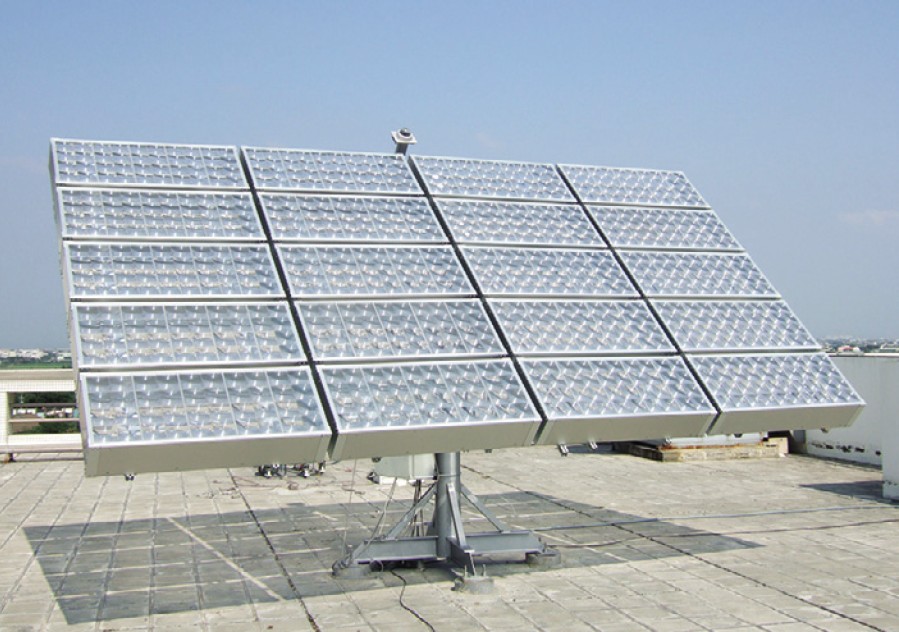By Sarah Jeong (pved1@infothe.com)

Please introduce briefly Everphoton to our readers.
Everphoton is one of the World’s leading HCPV components manufacturers and system integrators, founded in October 2007 by Yee-Fong Chemical, a large industrial chemicals manufacturers with 60 years of history and Everlight, one of the top five LED manufacturers in the World.
Please update us on Everphoton’s major technological advancements.
Everphoton has been dedicated itself in the core technologies of HCPV with focuses on triple junction cell, optical designs on lenses, advancement on the module performance and the system efficiency. Recent developments includes: Different HCPV module sizes with advance optical design and rooftop HCPV systems.
What are the current trends in the Taiwanese PV market?
In the CPV sector, we are very positive on the development of the CPV technology, with Asian’s number one CPV demo site being built in LuJu, Taiwan, it has generated awareness on the CPV technology and it’s remarkable output, which exceeds conventional PV by almost two times. The government and private companies in Taiwan are getting more familiar with the CPV and we do see many government tenders and non-profit organization are considering CPV as one of the solutions for energy saving projects. Taiwan’s PV industry relies heavily on export markets to Europe and the U.S.A., where the incentive is high and use of renewable energy concepts are widely accepted. Countries like Taiwan and China are mainly focus on the production of PV cells and panels and again, they are still focusing international markets. Germany used to be the No. 1 in the world with up to 50% PV installation, but that would be changed in the next 5 year. The U.S.A., Italy and other European countries, where incentives will speed up and topping Germany to be the export markets for Taiwan.
When do you think ‘grid parity’ reaches homes in Taiwan?
We don’t see it happen in recent years. Since the DOE has just announced the implementation on the FiT incentives program 2009 and starting to initiate PV projects 2010, there’s still a long way to get to the point where the cost of PV installation will be the same as the cost of using fossil fuels.
What do you see as the major threats to the growth of the Taiwanese PV market?
The integration abilities are the key to success. For Taiwanese PV industry to be compatible in the global market, being able to vertically integrate the technology and keep providing quality products are most important factors deciding the market share on the global scale where as in CPV, we see a great deal of potential in Taiwan. Taiwan has so much experience on LED and since the III V triple junctions cells’ production is similar to LED, Taiwan has abundant capability to manufacture high quality solar cells. Integration is another strong point for Taiwan, we work with up and down stream suppliers on a daily basis and we could deliver the solution in a cost saving and time efficient manner.
Asian PV players are emerging as major leaders in the global PV industry. What do you think are some of the factors behind the success?
Reasonable labor cost on manufacturing and good quality products. In Asian market, we have the streamline suppliers, from the cell making to the system installation. Unlike European and the U.S. markets, where the labors are high and much less competitive in up- and downstream integration, Taiwan moves very fast in initiating projects and particularly in CPV, we are looking at more installations worldwide and domestically for further development in the solar market.
Among solar PV segments including commercial, residential solar installations, which one do you think is the most important driver for the Taiwanese PV market?
I would say both of the commercial and residential. Once again, Taiwan needs great deal of support from the government to promote the solar technology not only outside of the country, but domestically as well. I personally think Taiwan government should help the industry by initiating more and more bigger projects to showcase different solar technologies, the ability of manufacturing good quality products, and the capability on the system integration.
Please tell us about your goals and ambitions in the near future.
We are looking into much more applications on CPV technology in the world, particularly in Asian market. Even CPV is still fairly new compared to PV, we believe that the public has become more aware of the technology, how it works and the fact that CPV, with higher efficiency, provides more power at the end of the day. We do need more installations to prove that the CPV system is bankable and it performs better than conventional PV, given the right weather condition, i.e., sufficient sunlight.
What are your expectations for the Taiwanese PV market for 2010?
Still growing. It seems that the FiT cut in Germany will not make too much damage on the demand of PV installation. The U.S.A, France, Italy and other parts of Europe are growing, so hopefully, the demand from these areas will make up the lost in Germany.
Please tell us briefly about the government incentive programs in Taiwan.
The FiT is separated in different categories for different technologies. Incentives for solar installations are :

Sarah Jeong is Editor of InterPV. Send your comments to pved1@infothe.com.
For more information, please send your e-mails to pved@infothe.com.
ⓒ www.interpv.net All rights reserved
|



